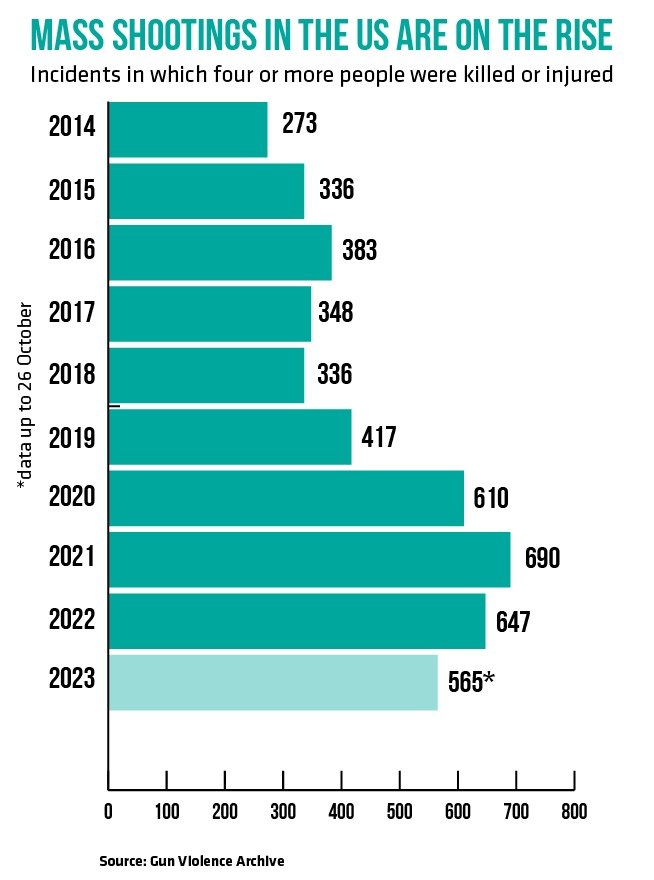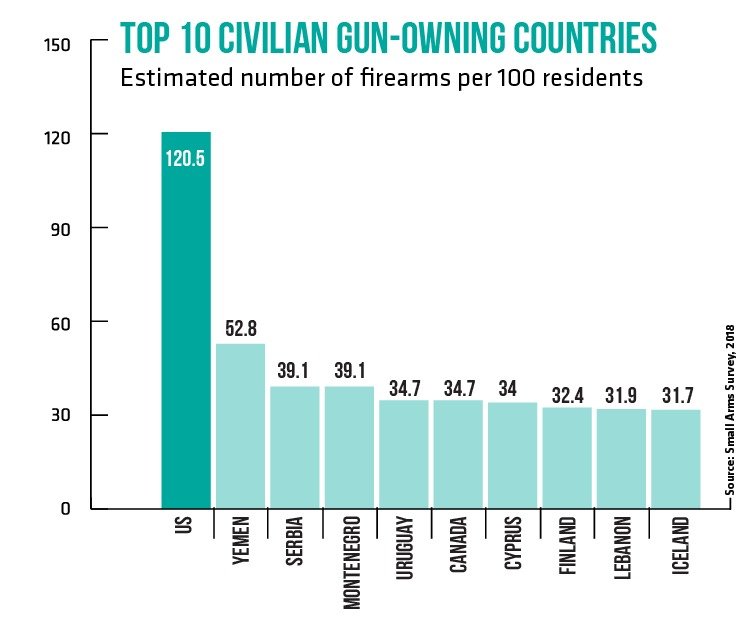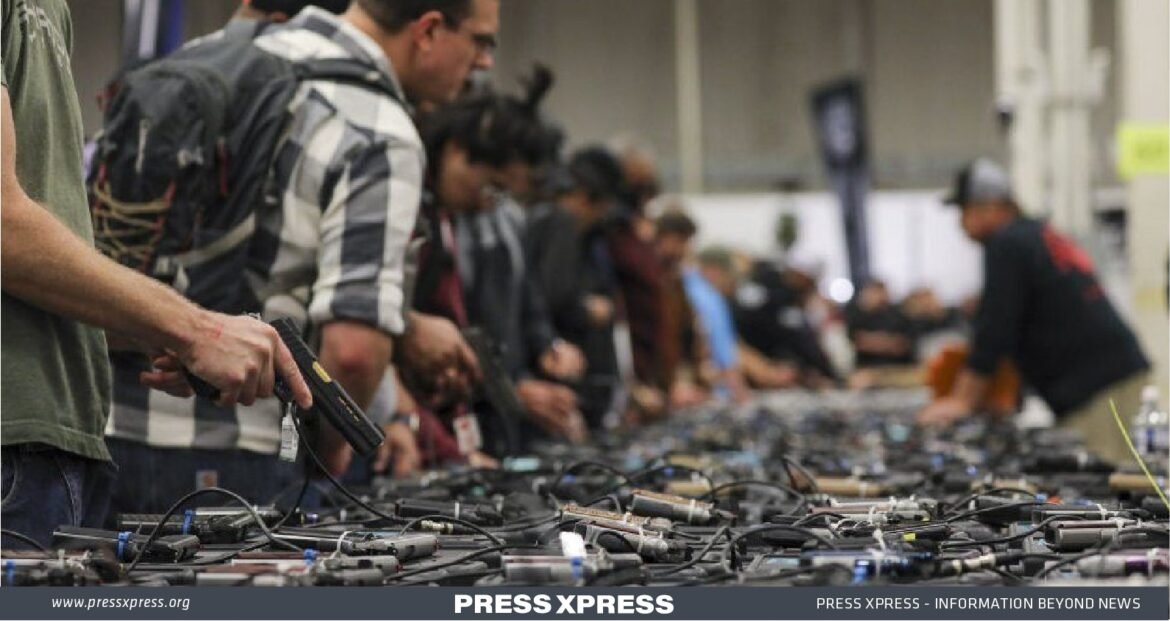The United States boasts a firearm ownership rate of 120.5 per 100 residents, a significant increase from 88 per 100 in 2011, surpassing the rates found in most other nations.
According to Maine Gov. Janet Mills, the tragic incident in Lewiston, Maine, on Oct. 25 claimed the lives of at least 18 people and left 13 others injured, making it the deadliest shooting of the year and one of the most lethal in recent decades.
Gun violence in the United States has consistently exceeded 39,000 deaths per year since 2014, as reported by Gun Violence Archive data. However, there has been a decline in gun-related fatalities compared to 2016, 2017, and 2018 when the annual death toll exceeded 50,000. In 2022, there were 44,310 such fatalities.
Fatal Gun-Violence on the Rise in 2023
American society grapples with the enduring problem of gun violence, and the resulting debate is fiercely political, with gun control supporters opposing those who vehemently uphold their right to bear arms. As of October 26th, the Gun Violence Archive reports that the United States has witnessed the loss of at least 35,275 lives due to gun violence this year, equating to an average of nearly 118 fatalities daily. Among the victims, 1,157 were teenagers, and 246 were children.
The predominant cause of gun-related deaths in 2023 has been suicide, with a total of 19,734 suicides by firearm, averaging around 66 per day. A significant number of these deaths have been concentrated in the states of Texas, California, Florida, Georgia, North Carolina, Illinois, and Louisiana.
The grim toll of gun violence fatalities includes 1,173 people who lost their lives in police officer-involved shootings, while 41 police officers have been fatally shot in the line of duty this year. Additionally, there have been 960 recorded instances of “unintentional” shootings, as reported by the Gun Violence Archive. In 2023, there have been more than 565 mass shootings, defined by the Gun Violence Archive as incidents in which four or more victims were shot or killed. These tragic events have led to 597 deaths and 2,380 injuries.

How are gun-related fatalities categorized in the United States?
The data from the US Centers for Disease Control and Prevention (CDC) reveals that in 2021, there were 48,830 fatalities in the United States attributed to gun-related injuries. It represents an almost 8% uptick from 2020, a year that set records for firearm-related fatalities.
While mass shootings and gun-related homicides tend to receive significant media attention, more than 50% of the total deaths in 2021 were due to suicides. The CDC’s statistics indicate that more than 20,000 deaths in that particular year were the result of homicides.
On a daily basis, over 50 people in the US lose their lives to firearms. The statistics indicate that the proportion of homicides in the US is significantly greater than in countries like Canada, Australia, England and Wales, as well as many others.
Examining the Prolific Gun Culture in the U.S.
Almost every state in the United States permits gun owners to carry concealed weapons in public to some extent. However, in over half of the states, most gun owners can carry concealed firearms in most public areas without needing a permit, undergoing a background check, or receiving safety training, as Republican lawmakers push forward with what they call a “constitutional carry” movement in state legislatures.
Estimating the global tally of privately-held firearms is a complex task, but according to the most recent statistics provided by the Small Arms Survey, a Swiss research endeavor, it is believed that there were 390 million guns in the United States in 2018. The United States boasts a firearm ownership rate of 120.5 per 100 residents, a significant increase from 88 per 100 in 2011, surpassing the rates found in most other nations.

How Americans feel about US gun laws?
The majority of Americans support gun control, with 57% of respondents in a Gallup poll respondents expressed a desire for more stringent gun laws. Notably, this percentage declined compared to the previous year. Notably, this percentage declined compared to the previous year.
In a separate Gallup survey, it was observed that almost 91% of respondents supported more stringent gun control laws. Conversely, only 24% of Republicans shared this view, while 45% of independent voters were in agreement.
Despite facing years of financial challenges and internal conflicts, the National Rifle Association (NRA) still stands as the most influential gun advocacy group in the United States, wielding a significant budget to shape the views of congressional members on firearm policy. Several states have even taken steps to significantly reduce regulations on firearm possession. In June 2021, Texas Governor Greg Abbott approved a “permitless carry bill,” which permits the state’s residents to carry handguns without a license or training, illustrating the extent to which some states have eased restrictions on gun ownership.
Furthermore, in April of last year, Georgia joined the ranks of 24 other states in eliminating the need for a concealed or open carry permit. This law now grants all Georgia residents the freedom to carry a firearm without the requirement of a license or permit.
In the face of escalating gun violence and a passionate debate over gun control, the United States continues to grapple with a sobering reality. The prevalence of firearms, varying perspectives on gun laws, and legislative changes in many states reflect a deeply ingrained gun culture. While the majority of Americans express support for stricter gun laws, the influence of gun advocacy groups and the easing of regulations in some states underscore the challenges in finding a comprehensive solution to this pressing issue. The need for dialogue, reform, and collective action remains paramount in addressing the toll of gun violence on American society.


